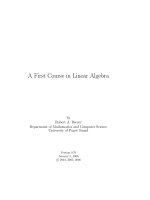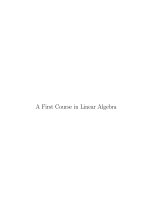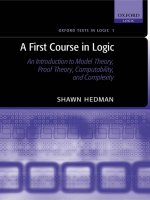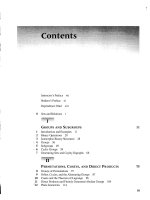A first course in abstract algebra by fraleigh 7ed textbook
Bạn đang xem bản rút gọn của tài liệu. Xem và tải ngay bản đầy đủ của tài liệu tại đây (6.56 MB, 521 trang )
7
Instructor's Preface
Student's Preface
vn
xi
Dependence Chart
xm
0
Sets and Relations
1
1
Introduction and Examples 11
Binary Operations 20
Isomorphic Binary Structures 28
Groups 36
Subgroups 49
Cyclic Groups 59
Generating Sets and Cayley Digraphs
11
GROUPS AND SUBGROUPS
2
3
4
5
- 6
7
68
PERMUTATIONS, COSETS, AND DIRECT PRODUCTS
8
9
10
11
t 12
Groups of Permutations 75
Orbits, Cycles, and the Alternating Groups 87
Co sets and the Theorem of Lagrange 96
Direct Products and Finitely Generated Abelian Groups
Plane Isometries 114
75
104
iii
Contents
iv
HOMOMORPHISMS AND FACTOR GROUPS
13
14
15
+16
t17
Homomorphisms 125
Factor Groups 135
Factor-Group Computations and Simple Groups
Group Action on a Set 154
Applications of G-Sets to Counting 161
144
167
RINGS AND FIELDS
18
19
20
21
22
23
t24
t2s
Rings and Fields 167
Integral Domains 177
Fermat's and Euler's Theorems 184
The Field of Quotients of an Integral Domain 190
Rings of Polynomials 198
Factorization of Polynomials over a Field 209
Noncommutative Examples 220
Ordered Rings and Fields 227
IDEALS AND FACTOR RINGS
26
27
t2s
Homomorphisms and Factor Rings
Prime and Maximal Ideals 245
Grabner Bases for Ideals 254
Introduction to Extension Fields
Vector Spaces 274
Algebraic Extensions 283
Geometric Constructions 293
Finite Fields 300
237
237
265
EXTENSION FIELDS
29
30
31
t32
33
125
265
•+iii&:::
ADVANCED GROUP THEORY
34
35
36
37
Isomorphism Theorems 307
Series of Groups 311
Sylow Theorems 321
Applications of the Sylow Theory
327
307
Contents
38
39
40
v
Free Abelian Groups 333
Free Groups 341
Group Presentations 346
355
GROUPS IN TOPOLOGY
41
42
43
44
Simplicial Complexes and Homology Groups 355
Computations of Homology Groups 363
More Homology Computations and Applications 371
Homological Algebra 379
389
FACTORIZATION
45
46
47
Unique Factorization Domains 389
Euclidean Domains 401
Gaussian Integers and Multiplicative Norms
407
415
AUTOMORPHISMS AND GALOIS THEORY
48
49
50
51
t 52
53
54
55
56
Automorphisms of Fields 415
The Isomorphism Extension Theorem
Splitting Fields 431
Separable Extensions 436
Totally Inseparable Extensions 444
Galois Theory 448
Illustrations of Galois Theory 457
Cyclotomic Extensions 464
Insolvability of the Quintic 4 70
Appendix: Matrix Algebra
Bibliography
Notations
424
477
483
487
Answers to Odd-Numbered Exercises Not Asking for Definitions or Proofs
Index
513
t
Not required for the remainder of the text.
1
This section is a prerequisite for Sections 17 and 36 only.
491
This is an introduction to abstract algebra. It is anticipated that the students have studied
calculus and probably linear algebra. However, these are primarily mathematical maturity prerequisites; subject matter from calculus and linear algebra appears mostly in
illustrative examples and exercises.
As in previous editions of the text, my aim remains to teach students as much about
groups, rings, and fields as I can in a first course. For many students, abstract algebra is
their first extended exposure to an axiomatic treatment of mathematics. Recognizing this,
I have included extensive explanations concerning what we are trying to accomplish,
how we are trying to do it, and why we choose these methods. Mastery of this text
constitutes a firm foundation for more specialized work in algebra, and also provides
valuable experience for any further axiomatic study of mathematics.
Changes from the Sixth Edition
The amount of preliminary material had increased from one lesson in the first edition
to four lessons in the sixth edition. My personal preference is to spend less time before
getting to algebra; therefore, I spend little time on preliminaries. Much of it is review for
many students, and spending four lessons on it may result in their not allowing sufficient
time in their schedules to handle the course when new material arises. Accordingly, in
this edition, I have reverted to just one preliminary lesson on sets and relations, leaving
other topics to be reviewed when needed. A summary of matrices now appears in the
Appendix.
The first two editions consisted of short, consecutively numbered sections, many of
which could be covered in a single lesson. I have reverted to that design to avoid the
cumbersome and intimidating triple numbering of definitions, theorems examples, etc.
In response to suggestions by reviewers, the order of presentation has been changed so
vii
viii
Instructor's Preface
that the basic material on groups, rings, and fields that would normally be covered in a
one-semester course appears first, before the more-advanced group theory. Section 1 is
a new introduction, attempting to provide some feeling for the nature of the study.
In response to several requests, I have included the material on homology groups
in topology that appeared in the first two editions. Computation of homology groups
strengthens students' understanding of factor groups. The material is easily accessible;
after Sections 0 through 15, one need only read about free abelian groups, in Section 38
through Theorem 38.5, as preparation. To make room for the homology groups, I have
omitted the discussion of automata, binary linear codes, and additional algebraic structures that appeared in the sixth edition.
I have also included a few exercises asking students to give a one- or two-sentence
synopsis of a proof in the text. Before the first such exercise, I give an example to show
what I expect.
Some Features Retained
I continue to break down most exercise sets into parts consisting of computations, concepts, and theory. Answers to odd-numbered exercises not requesting a proof again
appear at the back of the text. However, in response to suggestions, I am supplying the
answers to parts a), c), e), g), and i) only of my 10-part true-false exercises.
The excellent historical notes by Victor Katz are, of course, retained. Also, a manual
containing complete solutions for all the exercises, including solutions asking for proofs,
is available for the instructor from the publisher.
A dependence chart with section numbers appears in the front matter as an aid in
making a syllabus.
Acknowledgments
I am very grateful to those who have reviewed the text or who have sent me suggestions
and corrections. I am especially indebted to George M. Bergman, who used the sixth
edition and made note of typographical and other errors, which he sent to me along
with a great many other valuable suggestions for improvement. I really appreciate this
voluntary review, which must have involved a large expenditure of time on his part.
I also wish to express my appreciation to William Hoffman, Julie LaChance, and
Cindy Cody of Addison-Wesley for their help with this project. Finally, I was most
fortunate to have John Probst and the staff at TechBooks handling the production of the
text from my manuscript. They produced the most error-free pages I have experienced,
and courteously helped me with a technical problem I had while preparing the solutions
manual.
Suggestions for New Instructors of Algebra
Those who have taught algebra several times have discovered the difficulties and developed their own solutions. The comments I make here are not for them.
This course is an abrupt change from the typical undergraduate calculus for the
students. A graduate-style lecture presentation, writing out definitions and proofs on the
board for most of the class time, will not work with most students. I have found it best
Instructor's Preface
ix
to spend at least the first half of each class period answering questions on homework,
trying to get a volunteer to give a proof requested in an exercise, and generally checking
to see if they seem to understand the material assigned for that class. Typically, I spent
only about the last 20 minutes of my 50-minute time talking about new ideas for the next
class, and giving at least one proof. From a practical point of view, it is a waste of time
to try to write on the board all the definitions and proofs. They are in the text.
I suggest that at least half of the assigned exercises consist of the computational
ones. Students are used to doing computations in calculus. Although there are many
exercises asking for proofs that we would love to assign, I recommend that you assign
at most two or three such exercises, and try to get someone to explain how each proof is
performed in the next class. I do think students should be asked to do at least one proof
in each assignment.
Students face a barrage of definitions and theorems, something they have never
encountered before. They are not used to mastering this type of material. Grades on tests
that seem reasonable to us, requesting a few definitions and proofs, are apt to be low and
depressing for most students. My recommendation for handling this problem appears in
my article, Happy Abstract Algebra Classes, in the November 2001 issue of the MAA
FOCUS.
At URI, we have only a single semester undergraduate course in abstract algebra.
Our semesters are quite short, consisting of about 42 50-minute classes. When I taught
the course, I gave three 50-minute tests in class, leaving about 38 classes for which the
student was given an assignment. I always covered the material in Sections 0-11, 13-15,
18-23, 26, 27, and 29-32, which is a total of 27 sections. Of course, I spent more than
one class on several of the sections, but I usually had time to cover about two more;
sometimes I included Sections 16 and 17. (There is no point in doing Section 16 unless
you do Section 17, or will be doing Section 36 later.) I often covered Section 25, and
sometimes Section 12 (see the Dependence Chart). The job is to keep students from
becoming discouraged in the first few weeks of the course.
This course may well require a different approach than those you used in previous mathematics courses. You may have become accustomed to working a homework problem by
turning back in the text to find a similar problem, and then just changing some numbers.
That may work with a few problems in this text, but it will not work for most of them.
This is a subject in which understanding becomes all important, and where problems
should not be tackled without first studying the text.
Let me make some suggestions on studying the text. Notice that the text bristles
with definitions, theorems, corollaries, and examples. The definitions are crucial. We
must agree on terminology to make any progress. Sometimes a definition is followed
by an example that illustrates the concept. Examples are probably the most important
aids in studying the text. Pay attention to the examples. I suggest you skip the proofs
of the theorems on your first reading of a section, unless you are really "gung-ho" on
proofs. You should read the statement of the theorem and try to understand just what it
means. Often, a theorem is followed by an example that illustrates it, a great aid in really
understanding what the theorem says.
In summary, on your first reading of a section, I suggest you concentrate on what
information the section gives, and on gaining a real understanding of it. If you do not
understand what the statement of a theorem means, it will probably be meaningless for
you to read the proof.
Proofs are very basic to mathematics. After you feel you understand the information
given in a section, you should read and try to understand at least some of the proofs.
Proofs of corollaries are usually the easiest ones, for they often follow very directly from
the theorem. Quite a lot of the exercises under the "Theory" heading ask for a proof. Try
not to be discouraged at the outset. It takes a bit of practice and experience. Proofs in
algebra can be more difficult than proofs in geometry and calculus, for there are usually
no suggestive pictures that you can draw. Often, a proof falls out easily if you happen to
xi
xii
Student's Preface
look at just the right expression. Of course, it is hopeless to devise a proof if you do not
really understand what it is that you are trying to prove. For example, if an exercise asks
you to show that given thing is a member of a certain set, you must know the defining
criterion to be a member of that set, and then show that your given thing satisfies that
criterion.
There are several aids for your study at the back of the text. Of course, you will
discover the answers to odd-numbered problems not requesting a proof. If you run into a
notation such as Zn that you do not understand, look in the list of notations that appears
after the bibliography. If you run into terminology like inner automorphism that you do
not understand, look in the Index for the first page where the term occurs.
In summary, although an understanding of the subject is important in every mathematics course, it is really crucial to your performance in this course. May you find it a
rewarding experience.
Narragansett, Rl
J.B.F.
Dependence Chart
0-11
j:,
13-15
16
34
~
17
I
I
35
36
I
37
38
39
I
I
41-44
40
18-23
r-h
h
26
8
27
;;-h.,
29-33
I
48-51
j;,
53-54
55
56
SETS AND RELATIONS
On Definitions, and the Notion of a Set
Many students do not realize the great importance of definitions to mathematics. This
importance stems from the need for mathematicians to communicate with each other.
If two people are trying to communicate about some subject, they must have the same
understanding of its technical terms. However, there is an important structural weakness.
It is impossible to define every concept.
Suppose, for example, we define the term set as "A set is a well-defined collection of
objects." One naturally asks what is meant by a collection. We could define it as "A
collection is an aggregate of things." What, then, is an aggregate? Now our language
is finite, so after some time we will run out of new words to use and have to repeat
some words already examined. The definition is then circular and obviously worthless.
Mathematicians realize that there must be some undefined or primitive concept with
which to start. At the moment, they have agreed that set shall be such a primitive concept.
We shall not define set, but shall just hope that when such expressions as "the set of all
real numbers" or "the set of all members of the United States Senate" are used, people's
various ideas of what is meant are sufficiently similar to make communication feasible.
We summarize briefly some of the things we shall simply assume about sets.
1.
A set S is made up of elements, and if a is one of these elements, we shall
denote this fact by a E S.
2.
There is exactly one set with no elements. It is the empty set and is denoted
by 0.
3.
We may describe a set either by giving a characterizing property of the
elements, such as "the set of all members of the United States Senate," or by
listing the elements. The standard way to describe a set by listing elements is
to enclose the designations of the elements, separated by commas, in braces,
for example, { 1, 2, 15}. If a set is described by a characterizing property P(x)
of its elements x, the brace notation {x I P (x)} is also often used, and is read
"the set of all x such that the statement P(x) about x is true." Thus
{2, 4, 6, 8}
=
=
{x I x is an even whole positive number .::=: 8}
{2x I x
=
1, 2, 3, 4}.
The notation {xI P(x)} is often called "set-builder notation."
4.
A set is well defined, meaning that if S is a set and a is some object, then
either a is definitely inS, denoted by a E S, or a is definitely not inS, denoted
by a ¢:. S. Thus, we should never say, "Consider the set S of some positive
numbers," for it is not definite whether 2 E S or 2 ¢:. S. On the other hand, we
1
2
Section 0
Sets and Relations
can consider the set T of all prime positive integers. Every positive integer is
definitely either prime or not prime. Thus 5 E T and 14 ¢:. T. It may be hard to
actually determine whether an object is in a set. For example, as this book
goes to press it is probably unknown whether 2( 265 ) + 1 is in T. However,
265
2( ) + 1 is certainly either prime or not prime.
It is not feasible for this text to push the definition of everything we use all the way
back to the concept of a set. For example, we will never define the number JT in terms of
a set.
Every definition is an if and only
if type of statement.
With this understanding, definitions are often stated with the only if suppressed, but it
is always to be understood as part of the definition. Thus we may define an isosceles
triangle as follows: "A triangle is isosceles if it has two sides of equal length," when we
really mean that a triangle is isosceles if and only if it has two sides of equal length.
In our text, we have to define many terms. We use specifically labeled and numbered
definitions for the main algebraic concepts with which we are concerned. To avoid an
overwhelming quantity of such labels and numberings, we define many terms within the
body of the text and exercises using boldface type.
Boldface Convention
A term printed in boldface in a sentence is being defined by that sentence.
Do not feel that you have to memorize a definition word for word. The important
thing is to understand the concept, so that you can define precisely the same concept
in your own words. Thus the definition "An isosceles triangle is one having two equal
sides" is perfectly correct. Of course, we had to delay stating our boldface convention
until we had finished using boldface in the preceding discussion of sets, because we do
not define a set!
In this section, we do define some familiar concepts as sets, both for illustration and
for review of the concepts. First we give a few definitions and some notation.
0.1 Definition
A set B is a subset of a set A, denoted by B <;; A or A 2 B, if every element of B is in
A. The notations B c A or A :::) B will be used forB <;; A but B i= A.
•
· Note that according to this definition, for any set A, A itself and 0 are both subsets of A.
0.2 Definition
If A is any set, then A is the improper subset of A. Any other subset of A is a proper
subset of A.
•
Sets and Relations
3
0.3 Example
Let S = {1, 2, 3}. This set S has a total of eight subsets, namely 0, { 1}, {2}, {3},
{1, 2}, {1, 3}, {2, 3}, and {1, 2, 3}.
•
0.4 Definition
Let A and B be sets. The set A x B ={(a, b) I a E A and bE B} is the Cartesian
•
product of A and B.
0.5 Example
If A= {1, 2, 3} and B = {3, 4}, then we have
A
X
B
=
{(1, 3), (1, 4), (2, 3), (2, 4), (3, 3), (3, 4)}.
Throughout this text, much work will be done involving familiar sets of numbers.
Let us take care of notation for these sets once and for all.
Z is the set of all integers (that is, whole numbers: positive, negative, and zero).
Ql is the set of all rational numbers (that is, numbers that can be expressed as quotients
mjn of integers, where n -::j. 0).
lR is the set of all real numbers.
z:;+, Ql+, and JR+ are the sets of positive members of Z::, Ql, and R respectively.
IC is the set of all complex numbers.
Z::*, Ql*, JR*, and IC* are the sets of nonzero members of Z::, Ql, Rand IC, respectively.
0.6 Example
The set lR x lR is the familiar Euclidean plane that we use in first-semester calculus to
_.
draw graphs of functions.
Relations Between Sets
We introduce the notion of an element a of set A being related to an element b of set B,
which we might denote by a .YB b. The notation a .YB b exhibits the elements a and bin
left-to-right order, just as the notation (a, b) for an element in A x B. This leads us to
the following definition of a relation .YB as a set.
0.7 Definition
A relation between sets A and B is a subset~ of A x B. We read (a, b) E .~ as "a is
related to b" and write a .J'B b.
•
0.8 Example
(Equality Relation) There is one familiar relation between a set and itself that we
consider every set S mentioned in this text to possess: namely, the equality relation =
defined on a set S by
= is the subset {(x, x) I x E S} of S x S.
Thus for any x E S, we have x = x, but if x and y are different elements of S, then
(x, y) (j. =and we write x -::j. y.
_.
We will refer to any relation between a set S and itself, as in the preceding example,
as a relation on S.
0.9 Example
The graph of the function f where f(x) = x 3 for allx E IR, is the s4bset {(x, x 3 ) I x E JR}
of lR x R Thus it is a relation on R The function is completely determined by its graph .
•
4
Section 0
Sets and Relations
The preceding example suggests that rather than define a "function" y = f(x) to
be a "rule" that assigns to each x E lFt exactly one y E JR, we can easily describe it as a
certain type of subset of lFt x IR, that is, as a type of relation. We free ourselves from lFt
and deal with any sets X and Y.
0.10 Definition
A function cp mapping X into Y is a relation between X and Y with the property that
each x E X appears as the first member of exactly one ordered pair (x, y) in cp. Such a
function is also called a map or mapping of X into Y. We write cp : X --+ Y and express
(x, y) E cp by cp(x) = y. The domain of cp is the set X and the set Y is the codomain of
cp. The range of cp is cp[X] = {cp(x) I x EX}.
•
0.11 Example
We can view the addition of real numbers as a function + : (JR x JR) --+ lFt, that is, as a
mapping of lFt x lFt into R For example, the action of + on (2, 3) E lFt x lFt is given in
function notation by +((2, 3)) = 5. In set notation we write ((2, 3), 5) E +. Of course
our familiar notation is 2 + 3 = 5.
£.
Cardinality
The number of elements in a set X is the cardinality of X and is often denoted by [X[.
For example, we have I{2, 5, 7} I = 3 .It will be important for us to know whether two sets
have the same cardinality. If both sets are finite there is no problem; we can simply count
the elements in each set. But do Z, Q, and lFt have the same cardinality? To convince
ourselves that two sets X and Y have the same cardinality, we try to exhibit a pairing of
each x in X with only one y in Y in such a way that each element of Y is also used only
once in this pairing. For the sets X= {2, 5, 7} andY={?,!,#}, the pairing
2<:-+?,
5<:-+#,
7<:-+!
shows they have the same cardinality. Notice that we could also exhibit this pairing as
{(2, ?), (5, #), (7, !)} which, as a subset of X x Y, is a relation between X andY. The
pairing
1
4
5
8
10
2
3
t
t
t
t
t
t
t
t
t
t
0
-1
1
-2
2
-3
3
-4
4
-5
6
7
9
shows that the sets Z and z+ have the same cardinality. Such a pairing, showing that
sets X and Y have the same cardinality, is a special type of relation <:-+ between X and
Y called a one-to-one correspondence. Since each element x of X appears precisely
once in this relation, we can regard this one-to-one correspondence as a function with
domain X. The range of the function is Y because each y in Y also appears in some
pairing x <:-+ y. We formalize this discussion in a definition.
0.12 Definition
*A function cp : X --+ Y is one to one if cp(x 1) = cp(x2) only when x 1 = x 2 (see Exercise 37). The function cp is onto Y if the range of cp is Y.
•
*We should mention another terminology, used by tbe disciples of N. Bourbaki, in case you encounter it
elsewhere. In Bourbaki's terminology, a one-to-one map is an injection, an onto map is a surjection, and a
map that is both one to one and onto is a bijection.
Sets and Relations
5
If a subset of X x Y is a one-to-one function¢ mapping X onto Y, then each x E X
appears as the first member of exactly one ordered pair in¢ and also each y E Y appears
as the second member of exactly one ordered pair in¢. Thus if we interchange the first
and second members of all ordered pairs (x, y) in¢ to obtain a set of ordered pairs (y, x ),
we get a subset of Y x X, which gives a one-to-one function mapping Y onto X. This
function is called the inverse function of¢, and is denoted by q;- 1. Summarizing, if
¢maps X one to one onto Y and ¢(x) = y, then q;- 1 maps Y one to one onto X, and
q;-1(y)
=X.
0.13 Definition
Two sets X and Y have the same cardinality if there exists a one-to-one function mapping
X onto Y, that is, if there exists a one-to-one correspondence between X and Y.
•
0.14 Example
The function f : lR --+ lR where f (x) = x 2 is not one to one because f (2) = f (- 2) = 4
but 2 # -2. Also, it is not onto lR because the range is the proper subset of all nonnegative
numbers in JR. However, g : lR --+ lR defined by g(x) = x 3 is both one to one and onto
JR.
~
We showed that :Z and :z+ have the same cardinality. We denote this cardinal number
by ~ 0 , so that I:Z I = I:z+ I = ~ 0 . It is fascinating that a proper subset of an infinite set
may have the same number of elements as the whole set; an infinite set can be defined
as a set having this property.
We naturally wonder whether all infinite sets have the same cardinality as the set :Z.
A set has cardinality ~o if and only if all of its elements could be listed in an infinite row,
so that we could "number them" using :z+. Figure 0.15 indicates that this is possible
for the set Q. The square array of fractions extends infinitely to the right and infinitely
downward, and contains all members of Q. We have shown a string winding its way
through this array. Imagine the fractions to be glued to this string. Taking the beginning
of the string and pulling to the left in the direction of the arrow, the string straightens
1, -1, ~, · · · . Thus
out and all elements of Q appear on it in an infinite row as 0,
IQI = ~o also.
! , -!,
0.15 Figure









